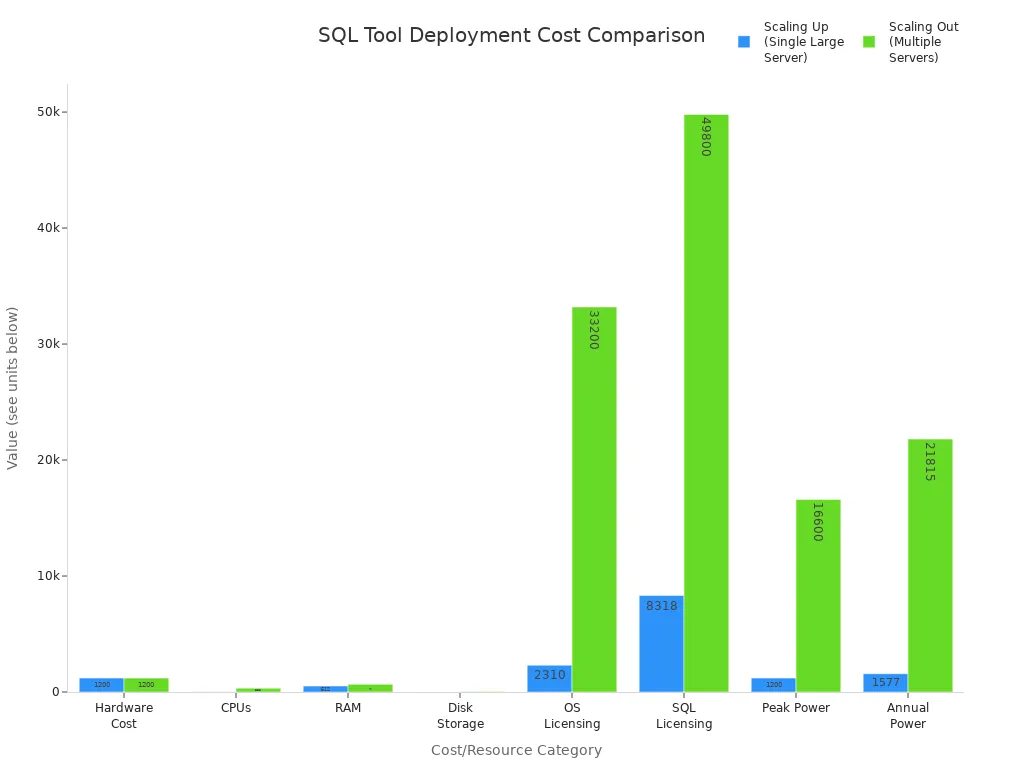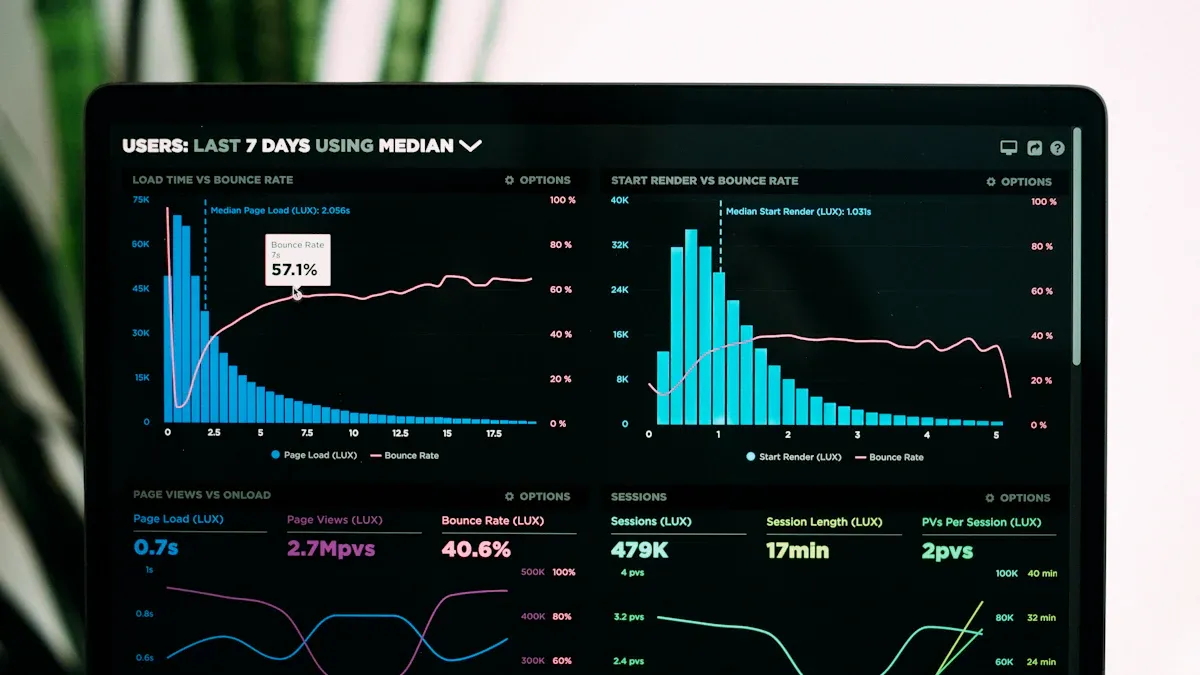How I Evaluate and Select Tools That Contain SQL for Scalable Applications

You need a clear framework when you evaluate and select any tool that contains sql for scalable applications. Nearly half of all web applications use SQL-based databases, with a 75% adoption rate in IT, showing that most modern solutions rely on tools that contain sql for data management. Focus your assessment on critical criteria such as sharding, replication, performance monitoring, cost-efficiency, security, and cloud integration. Aligning your choice with your business growth patterns ensures your database infrastructure supports both current and future demands.
Key Takeaways
Choose SQL tools that support your application's growth by focusing on scalability features like sharding, replication, and cloud integration.
Prioritize performance by measuring response time, throughput, and resource use to ensure fast and reliable database operations.
Ensure strong security with encryption, access controls, and compliance with standards like GDPR and HIPAA to protect your data.
Consider total costs including hardware, licensing, and maintenance to find a cost-effective solution that fits your budget.
Match your team's SQL skills with the tool's complexity, and use AI-powered tools like Chat2DB to simplify management and boost productivity.
Scalability Needs
Growth Patterns
You must understand how your application will grow over time to select the right database tools. Growth patterns in data-driven applications often include increased user numbers, expanding data sources, and more complex queries. Many organizations see growth through enhanced collaboration, online editing, and real-time analytics. Teams use visual design tools and dashboards to make data more accessible. As your application development progresses, you may adopt cloud storage, integrate AI, or use advanced analytics. These trends require a flexible database that can scale with your needs.
Tip: Plan for both horizontal and vertical scaling. Horizontal scaling adds more database servers, while vertical scaling increases the power of existing hardware. Each approach has trade-offs in cost, complexity, and resilience.
Common challenges during growth include:
Coordinating many interconnected components in your application.
Managing increased costs for hardware, software, or cloud resources.
Identifying and resolving performance bottlenecks.
Maintaining data consistency across distributed systems.
Data Volume
Data volume plays a critical role in your database selection. As your application development continues, data will grow from thousands to millions or even billions of records. Scalable databases handle this growth without major redesigns or downtime. You need a solution that maintains performance and reliability as data increases. For example, Netflix migrated from Oracle to Cassandra to manage exponential data growth and maintain high performance. Distributing load across multiple servers ensures your application remains responsive.
A scalable database also improves cost efficiency by using commodity hardware and built-in fault tolerance. You can future-proof your application by choosing a database that supports seamless scaling as your business expands.
Business Goals
Your business goals should drive your database and application development choices. Enterprises select SQL tools to ensure data integrity, accessibility, and security across functions like HR, CRM, e-commerce, and financial systems. Reliable and secure data management supports reporting, analytics, and business intelligence. Performance optimization enables real-time analytics and data-driven insights.
Scalability remains a top priority for handling growing data volumes efficiently. Security and compliance are essential, especially in regulated industries. Operational agility and centralized monitoring help manage complex environments. Many organizations now seek databases that empower non-technical users and integrate AI for predictive analytics. Real-world examples, such as using PostgreSQL on AWS for air quality analytics, show how aligning database capabilities with business goals leads to operational efficiency and reliability.
Key Criteria for Tools That Contain SQL
Selecting the right tool that contains sql for scalable applications requires you to evaluate several essential criteria. You must focus on performance, security, cost, and your team’s skills. Each factor directly impacts how well your solution supports growth, maintains data integrity, and delivers the best user experience. Let’s break down these criteria to help you make informed decisions.
Performance
Performance stands at the core of any solution that contains sql. You need to measure how your sql databases handle increasing workloads, large data volumes, and complex queries. The best approach involves using clear metrics to compare distributed sql solutions and relational database management system options.
Significance | Measurement Methods | Impact on Scalability and User Experience | |
|---|---|---|---|
Response Time | Measures how quickly the system responds to user requests; critical for user satisfaction and identifying bottlenecks. | Performance testing tools (LoadRunner, JMeter), real-time monitoring tools | Faster response times improve user experience and competitive advantage. |
Throughput | Number of transactions or queries processed per second; indicates database efficiency under load. | Monitoring TPS (Transactions Per Second), QPS (Queries Per Second), SQL profilers, load testing tools | High throughput supports rapid data processing and handles peak loads effectively. |
Latency | Delay in data processing or network communication; affects overall responsiveness. | Network tools (ping, traceroute), profiling tools, TTFB (Time to First Byte) | Minimizing latency improves responsiveness; caching and network optimization help reduce it. |
Resource Utilization | CPU, memory, and I/O usage metrics; indicate system load and potential bottlenecks. | System monitoring tools tracking CPU %, memory usage, I/O operations | Helps identify overloads and optimize resource allocation for scalability. |
Error Rate | Frequency of errors in system operations; reflects accuracy and reliability. | Statistical methods (MSE, MAE), automated testing, defect-tracking software | Lower error rates improve operational effectiveness and maintain quality. |
You should also consider how different sql server solutions handle query execution speed and throughput:
Simple queries often perform similarly across leading sql databases, as vendors optimize for these cases.
Parallelism varies. MySQL supports parallelism between connections, while other distributed sql solutions may offer parallelism within a single connection.
Hardware choices, such as SSDs versus HDDs, and system settings can greatly affect throughput and latency.
Caching can make the first query slower than subsequent runs, so always test with real workloads.
Network latency, especially in cloud environments, can dominate query times for simple queries.
Throughput depends on concurrent query handling. Some sql server solutions degrade after a certain number of active connections.
The best benchmarking method is to replay real workload queries against a consistent database snapshot.
Chat2DB stands out by supporting multi-database environments, enabling you to monitor performance across various sql databases from a single interface. Its AI-driven query optimization and error correction features help you maintain high performance and data integrity as your application scales.
Security
Security is non-negotiable for any solution that contains sql, especially when handling sensitive data or operating in regulated industries. You must ensure your sql server and distributed sql databases protect data at rest and in transit, enforce strict access controls, and support compliance with major standards.
Key security features to look for include:
Encryption methods such as Always Encrypted, Transparent Data Encryption (TDE), and cell-level encryption.
Auditing and monitoring tools to track database activities, support compliance, and detect unauthorized actions.
Strict access control using the principle of least privilege, often implemented with role-based access control (RBAC).
Network security measures, including firewalls and SSL/TLS for secure communication.
Regular patch management and backup protection with encrypted storage.
Mitigation of sql injection risks through parameterized queries and input validation.
Real-time monitoring of server changes and failed logins to detect attacks.
Key Features Supporting Compliance | |
|---|---|
GDPR | Sensitive data discovery, data masking, continuous auditing, breach detection |
HIPAA | Data audit, breach investigation, access control, encryption support |
SOX | Detailed logging, access control, reporting for auditors |
PCI DSS | Data security, query blocking, data masking, user activity monitoring |
Modern tools like Chat2DB deliver robust security by processing queries locally, using end-to-end encryption, and supporting SSH tunneling. You can audit all sql executed within your team, ensuring operational transparency and compliance with standards such as GDPR, HIPAA, SOX, and PCI DSS.
Tip: Always choose a solution that contains sql with strong auditing, encryption, and access control to protect your data and maintain compliance.
Cost
Cost plays a major role in selecting the best sql server or distributed sql solution. You must consider hardware, licensing, maintenance, and operational expenses. The total cost of ownership can vary widely based on your scaling strategy and licensing model.
Scaling Up (Single Large Server) | Scaling Out (Multiple Smaller Servers) | |
|---|---|---|
Hardware Cost (per server) | Approx. $1,200 | Approx. $1,200 per server, multiplied by number of servers |
CPUs | 32 cores total | 332 cores total |
RAM | 512 GB | 664 GB |
Disk Storage | 4 TB | 40.5 TB |
OS Licensing Cost | $2,310 | $33,200 (much higher due to multiple servers) |
SQL Server Licensing Cost | $8,318 | $49,800 (significantly higher due to scaling out) |
Peak Power Consumption | 1,200 watts | 16,600 watts |
Annual Power Cost | $1,577 | $21,815 |

Licensing models impact your costs:
Core-based licensing increases with the number of physical cores, raising expenses for large servers.
Subscription-based pricing offers predictable budgeting and includes updates and support.
Pay-as-you-go models, like Azure Arc, charge based on actual usage, optimizing costs for variable workloads.
Cloud deployment options provide savings through elastic resource allocation and reserved instance pricing.
Server + CAL licensing works for smaller user bases but becomes less economical as your user count grows.
You must also account for hidden costs, such as infrastructure dependencies, administrator salaries, training, and disaster recovery. Open-source solutions like Chat2DB, licensed under Apache 2.0, help reduce licensing costs while providing advanced database management features.
Team Skills
Your team’s expertise determines how effectively you can use advanced sql tools and distributed sql solutions. Managing modern sql databases requires more than basic querying. You need skills in query optimization, performance tuning, and automation.
Teams need at least intermediate sql knowledge to manage connections, write efficient queries, and handle data insertion.
Advanced skills become necessary for complex data operations, such as window functions, recursive queries, and scalable data pipelines.
Mastery of advanced sql enables your team to build reliable, maintainable, and automated data operations.
The required expertise level varies by industry, but production environments like e-commerce or banking demand advanced skills.
Learning advanced sql is a progressive process, often acquired on the job.
Chat2DB lowers the barrier for teams by offering an intuitive interface, AI-driven query generation, and automatic error correction. Even users with limited sql experience can manage multiple sql databases, visualize data, and perform optimization tasks efficiently.
Note: Always match your solution to your team’s skill level. The best tools empower your team to achieve high performance, maintain data integrity, and support business growth.
Comparing SQL Solutions
Selecting the right sql solutions for scalable applications requires a structured approach. You need to compare sql databases, distributed sql platforms, and sql server tools using practical, repeatable methods. This section guides you through proven evaluation strategies, industry-standard benchmarks, and real-world testing practices. You will also see how tools like Chat2DB streamline multi-database management and text-to-sql workflows during evaluation.
Evaluation Methods
You should start by applying systematic evaluation methods to assess sql solutions. These methods help you measure the effectiveness of sql generation, query accuracy, and overall solution reliability. The following table summarizes the most effective evaluation methods for text-to-sql and distributed sql environments:
Evaluation Method | Description | Advantages | Disadvantages | Real-World Relevance |
|---|---|---|---|---|
Execution Accuracy (EX) | Measures if generated sql queries produce the same results as ground truth queries when executed | Directly assesses functional correctness; ensures reliable outputs; reveals model weaknesses on complex queries | Requires suitable database environment; time-consuming due to query execution overhead | Used by models like T5; highlights real-world performance especially on complex datasets |
Valid Efficiency Score (VES) | Combines query validity and execution efficiency, focusing on producing valid and performant sql | Encourages generation of valid and efficient queries; balances accuracy and performance | Does not directly measure execution accuracy; may miss nuances in complex queries | Used by CodeS model; suitable for applications needing speed and accuracy |
FLEX (False-Less Execution Metric) | Focuses on minimizing false positives by rigorously validating execution results | Reduces misleading results; provides rigorous accuracy assessment | Computationally intensive; complex to implement | Used by PremSQL; ensures reliability even with ambiguous or complex queries |
Test-suite Accuracy (TS) | Uses a focused test suite from many databases to evaluate syntactic and semantic correctness | Comprehensive evaluation; high code coverage; benchmarks semantic accuracy; generalizes across schemas | Resource-intensive to build test suites; may miss some edge cases; does not assess query optimization | Used in benchmarks like Spider, SPARC, COSQL; valuable for diverse real-world database scenarios |
LLM as Judge | Uses large language models to semantically evaluate sql query results | Provides nuanced, context-aware evaluation; handles complex queries better than traditional methods | Requires significant computational resources; potential bias from training data | Emerging method; useful for complex semantic understanding beyond syntax |
You can use these methods to compare text-to-sql solutions, distributed sql platforms, and sql server tools. Chat2DB enhances this process by supporting multi-database environments, enabling you to run and validate queries across different sql databases. Its AI-driven text-to-sql generation and error correction features help you assess the quality of generated queries quickly.
Tip: Use a combination of execution accuracy and test-suite accuracy to ensure your text-to-sql solutions deliver both correctness and robustness across diverse database schemas.
Benchmarks
Benchmarks provide a standardized way to measure the performance of sql solutions. You should use industry-standard datasets and tools to compare sql server, distributed sql, and text-to-sql platforms under realistic workloads. The TPC-H benchmark is widely recognized for evaluating sql tool performance. It simulates complex analytical queries on large datasets, helping you understand how different sql databases and solutions handle real-world data pipelines.
HammerDB is another essential benchmarking tool. It allows you to generate repeatable OLTP workloads and measure the performance of sql server and distributed sql solutions in cloud or on-premises environments. HammerDB helps you observe how performance changes as you increase the number of virtual users. You will notice that performance trends vary based on workload characteristics, hardware, and system configuration. Benchmarking is not about absolute scores but about generating consistent workloads for comparison across environments.
When you run benchmarks, you should:
Use the same dataset and workload for each sql solution.
Simulate high-load conditions to identify bottlenecks in sql server and distributed sql platforms.
Analyze how performance levels off as user counts increase.
Document hardware and configuration details for reproducibility.
Note: Benchmarking under high load requires careful planning. Always isolate your test environment to avoid impacting production systems.
Real-World Testing
Real-world testing ensures that your sql solutions perform reliably before deployment. You need to validate text-to-sql generation, distributed sql scalability, and sql server integration using comprehensive testing strategies. Follow these best practices for effective real-world testing:
Conduct unit, integration, regression, performance, scalability, resilience, security, user-acceptance, and usability testing to cover all aspects of sql tool functionality.
Use high-quality, realistic test data that mimics live data characteristics. Apply data masking or advanced test data generation tools to protect sensitive information.
Automate testing processes and integrate them with CI/CD pipelines for frequent and efficient execution.
Involve stakeholders early, especially during User Acceptance Testing, to ensure the sql solutions meet business and user requirements.
Develop a detailed test plan with strategy, scope, timelines, and comprehensive test cases.
Set up realistic test environments that simulate production conditions.
Execute specialized queries designed for testing and document any issues found.
Perform security testing using both manual and automated penetration tests.
Use scalability and resilience testing to verify that sql databases and distributed sql solutions maintain performance under increased workloads.
Complement UAT with usability testing to gather feedback on interface convenience and performance speed.
Leverage modern database management tools like Chat2DB to generate realistic test data, automate test execution, and integrate testing into DevOps workflows.
Maintain continuous testing throughout the development lifecycle to ensure reliability, security, and alignment with business needs.
Organizations measure the success of sql tool pilots by defining clear success criteria across technical performance, user experience, business impact, and readiness for scaling. You should design pilot programs with controlled environments and structured learning objectives. Continuous feedback from stakeholders and comprehensive monitoring help you assess integration, adoption, and governance. Measurable business outcomes, such as cost reduction and improved customer satisfaction, indicate pilot success.
Chat2DB supports your real-world testing by enabling you to manage multiple sql databases, generate text-to-sql queries, and validate results across distributed sql and sql server environments. Its AI-driven features streamline query generation, error correction, and performance monitoring, making it easier to evaluate and select the best solution for your needs.
SQL Optimization and Query Optimization

Performance Tuning
You need to apply the best practices for sql optimization to achieve high query performance in scalable applications. Start by continuously monitoring database activity. This helps you spot performance bottlenecks early. Break down complex queries into simpler parts. This makes optimization easier and improves query execution. Always index fields used in JOIN conditions. Proper indexing reduces matching time and speeds up queries. Optimize join order and types by reviewing execution plans. Restructure correlated subqueries into efficient JOINs or window functions. Use temporary tables to store intermediate results for reuse. Avoid functions in WHERE predicates so indexes remain effective. For large, read-heavy tables, employ columnstore indexes. Guide the optimizer with SQL hints when needed. Leverage partitioned and materialized views to boost query speed on big datasets. Apply best practices like avoiding SELECT *, using LIMIT clauses, managing indexes, and parameterizing queries. These techniques directly improve sql optimization, reduce server load, and accelerate business insights.
Error Handling
Effective error handling is essential for sql optimization in large-scale deployments. You should use tools that support schema versioning and automated QA. Database versioning tools help maintain schema consistency and enable rollback. Automated syntax analysis detects issues before deployment. Post-deployment validation, such as checksum comparisons and automated queries, ensures data consistency. Embedding small tests in your sql scripts can trigger rollbacks if errors occur. Comparing your database schema against a known good state validates migration scripts. These practices create a robust QA process that minimizes risks and errors. Controlled deployment options, source control integration, and CI/CD support further reduce human error and speed up releases. Debugging tools and static code analysis identify syntax errors and security risks early, supporting safer deployments and better query optimization.
AI Assistance
AI-driven tools now play a major role in sql optimization and query optimization. These tools automate indexing, suggest query rewrites, and adapt execution plans in real time. AI can detect anomalies that affect query performance and recommend fixes. Cloud providers use AI models to monitor and optimize queries without manual intervention. This leads to faster query execution and reduces the workload for database administrators. AI-driven optimization improves efficiency, accuracy, and scalability in complex environments. Chat2DB leverages AI to generate text-to-sql queries, fix errors automatically, and optimize queries for better performance. You can use natural language to create queries, making sql optimization accessible even if you have limited experience. AI also helps you analyze historical query performance, predict efficient execution plans, and automate routine optimization tasks. This results in faster, more reliable database operations and supports real-time decision making.
Migration and Integration
Data Migration
Migrating data to a new SQL tool requires careful planning and execution. You often face challenges such as compatibility issues with new systems, data loss, and security concerns. Downtime and business disruption can occur if you do not validate your migration process. Inaccurate or incomplete data, legacy technology, and transferring unnecessary data can complicate the process. Many teams underestimate the timeline, leading to rushed transitions. To avoid these pitfalls, you should:
Set up pre-production validation environments for side-by-side testing.
Obfuscate sensitive fields or exclude non-essential personally identifiable information during migration.
Test thoroughly to prevent costly failures and ensure data integrity.
Chat2DB streamlines migration with robust import/export capabilities and multi-format support. You can move large datasets between different server environments efficiently. The platform’s operational transparency allows you to audit every step, reducing the risk of errors.
Integration
Integrating new SQL tools with your existing systems is essential for seamless workflows. SQL tools connect with current databases, data warehouses, and data lakes, supporting real-time data processing and synchronization. You can automate data sharing across applications, such as linking your server to CRM or ERP systems. AI-powered SQL tools like Chat2DB enable natural language query generation and automated code review, embedding quickly into your workflows. This integration supports collaboration and automation without heavy coding.
Tip: Use workflow automation platforms to sync your server with business tools, eliminating manual uploads and enabling real-time updates.
Maintenance
Long-term scalability depends on proactive maintenance. You should implement caching with in-memory stores like Redis to reduce server load. Use read replicas to distribute requests and improve availability. Horizontal scaling, or sharding, partitions large datasets across multiple servers, supporting growth beyond single-server limits. Adopt stateless application design by externalizing session data and removing client affinity. Offload intensive operations to background tasks to keep your main server responsive. Plan your partitioning and sharding strategies carefully to avoid uneven data distribution.
Chat2DB’s operational transparency and support for both SQL and NoSQL databases help you maintain a scalable, reliable environment. You can monitor server performance, automate backups, and ensure compliance with evolving business needs. Many organizations now use database-as-a-service solutions to simplify scaling and maintenance, allowing you to focus on innovation.
You need a structured approach to select the right SQL solution for your application. Start by evaluating server performance, scalability, and security. Consider real-world needs, future growth, and the ability to manage multiple server environments. Case studies show that choosing the right server and development partner ensures long-term scalability and reliability. Use this checklist for your next application:
Assess server compatibility and cross-platform support.
Test scalability with both vertical and horizontal strategies.
Prioritize automation, usability, and advanced reporting.
Ensure ongoing server maintenance and proactive support.
Modern solutions like Chat2DB simplify server management, automate optimization, and support diverse application requirements. You can achieve efficient, secure, and scalable database operations with the right tools.
FAQ
What should you prioritize when choosing a SQL tool for scalability?
You should focus on performance, security, and ease of integration. Make sure the tool supports your expected data growth and aligns with your business goals. Evaluate features like multi-database support and automation to future-proof your application.
How does Chat2DB help teams with limited SQL experience?
Chat2DB uses AI to generate SQL queries from natural language. You can fix errors automatically and visualize data easily. This lowers the learning curve, so even beginners can manage databases and optimize queries with confidence.
Can you use Chat2DB with both SQL and NoSQL databases?
Yes, you can connect Chat2DB to popular SQL databases like MySQL and PostgreSQL, as well as NoSQL options such as MongoDB and Redis. This flexibility lets you manage all your data sources from one platform.
What security features should you look for in a SQL management tool?
Always check for end-to-end encryption, role-based access control, and audit logging. These features protect your data and help you meet compliance standards like GDPR and HIPAA.
How do you test if a SQL tool fits your real-world needs?
You should run benchmarks, simulate real workloads, and involve your team in hands-on trials. Use tools like Chat2DB to automate query testing and monitor performance across different environments.
See Also
Best Artificial Intelligence Software For SQL Creation 2024
In-Depth Analysis Of Leading Text To SQL Tools 2025
Comparing Chat2DB With Conventional SQL Software Solutions

